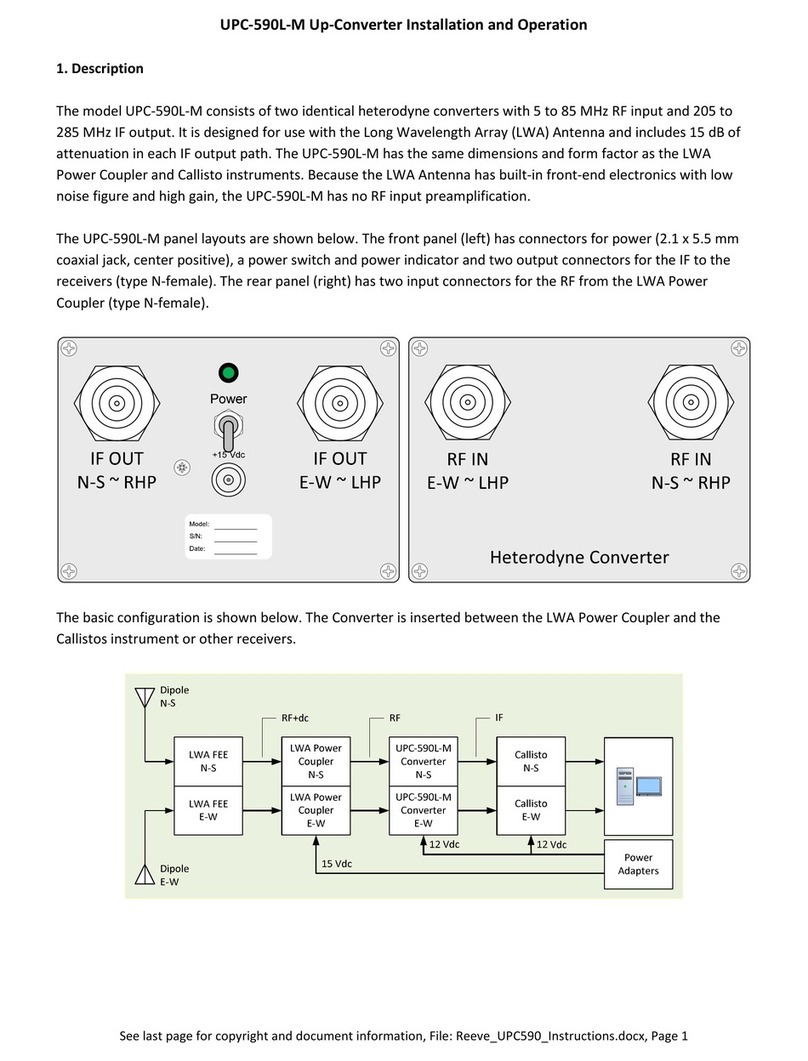
UPC-1 Up-Converter Installation and Operation
See last page for copyright and document information, File: Reeve_ConverterInstructions.doc, Page 8
Appendix I ~ Restore Modified UPC-1 Converter
he unmodified UPC-1 converter has an internal low noise amplifier and provides approximately +16 dB
conversion gain. he LWA Antenna is an active antenna with 35 dB gain and 2.7 dB noise figure. herefore,
when the LWA Antenna is used with the UPC-1 and Callisto instrument, the internal amplifier in the UPC-1 is
not required and the IF Output level must be reduced.
Factory modifications include disconnection of the UPC-1 internal amplifier (both RF and power) and insertion
of a 20 dB attenuator in series with the IF Output. hese modifications are made in the factory prior to
shipment when it is known that the UPC-1 will be used with the LWA Antenna. Modified units are labeled
“Modified for LWA Antenna”. he modifications are done in such a way that they are easily reversible. he
coaxial cables are left connected to the amplifier and the two conductors with socket terminal contacts for
amplifier power are removed from the power supply connector.
he following steps are required to reverse the modifications:
1.
Remove the UPC-1 top clamshell cover by removing the four screws in the upper corners of the two
end panels. Set the cover and screws aside;
2.
Remove the coaxial cable between the Mixer IF port and the Attenuator. Also remove the Attenuator
and SMA-F coupler (female-female adapter) from the IF Output cable. he cable, Attenuator and
adapter are no longer needed;
3.
Remove the IF Output end panel by removing the two screws in the lower corners. Set the end panel
and screws aside;
4.
Remove the coaxial cable between the Filter output port (this is the port closest to the IF Output end
panel) and the Mixer RF port. he cable is no longer needed;
5.
Connect the cable on the IF Output connector to the IF port on the Mixer. orque the connection;
6.
Replace the IF Output end panel;
7.
Connect the cable on the Amplifier Out port to the Mixer RF port. orque the connection;
8.
Connect the cable on the Amplifier In port to the Filter output port. orque the connection;
9.
Carefully remove the Power Connector from the K2 header on the dc Power Supply module.
Remember its orientation (one end is painted red). Make a sketch of the Power Supply and Power
Connector orientation for reference later. Do not disturb the connectors on K1 or K3;
10.
Carefully remove the heat shrink tubing from the end of the white and black power conductors
connected to the Amplifier. Be careful to not damage the socket terminal contacts while removing the
tubing.
11.
Examine the two socket terminal contacts. Locate and identify the small metal lip on one side of each
contact;
12.
Orient the contact on the white conductor so that the lip is pointed toward the outside of the Power
Connector and slip it into position 1. Note the small window in the connector – the contact should click
into position and the small lip should be visible in the window;
13.
Repeat the previous step with the black conductor except place it into position 2;
14.
Reconnect the Power Connector to the K2 header on the Power Supply module being careful to orient
it the same as when removed. he black conductors on the Power Connector should be closest to the
edge of the PCB. Check that the power connector on K3 has not been disturbed;




























